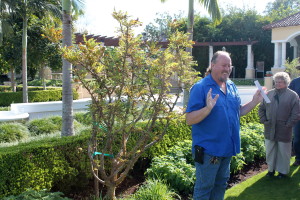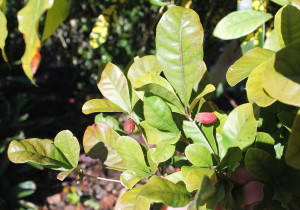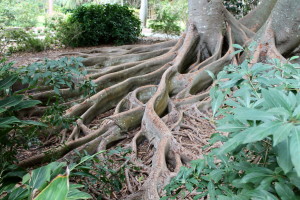Wild and Crazy Plants
February 23rd, 2016
Our landscape plants put on a nice show, what with their colorful summer flowers, their flashy fall foliage and their versatile shapes, sizes and textures.

Hollis Garden gardener Stacy Smith shows us the $30,000 frankincense tree.
But head into tropical or subtropical territory, and you’ll find plants that do some wild and weird things.
I’m just back from leading an 8-day tour to see gardens of central Florida, and our group of 39 plant-gawkers ran into some curiosities you don’t see every day in Steelton or New Cumberland. (See my newest Photo Gallery for a look. Or if you’re ever thinking about heading down there yourself, check out the 3-bedroom, pool-equipped villa in a gated community that our daughter, Erin, rents just 15 minutes from the Disney gates.)
We can do many of these plants as house plants or summer annuals. For others, you just have to marvel at how diverse and creative plants can be. Some of the more curious of what we saw…
* The $30,000 frankincense tree. Ever wonder the source of the little fragrant frankincense pellets that date to use in Biblical times? They come from a small-leafed, multi-stemmed tree that isn’t particularly attractive.
The costly pellets result from wounding the branches and drying and collecting the tear-drop-sized sap.
The 6-foot tree we saw is displayed at Hollis Garden – a city-owned garden in Lakeland. It was donated by a gardening citizen who wanted to remain anonymous.
Hollis has a security camera pointed at the tree because it’s so rare and worth $30,000. Nice gift.

Miracle fruits turn our sour taste buds sweet.
* Miracle fruit. This bush (Synsepalum dulcificum) produces small, red, oval fruits that have the odd ability to turn our sour taste buds sweet. For about 20 minutes after you eat miracle fruit, even lemons taste deliciously sweet.
We saw this one at Hollis, too, where head gardener Stacy Smith told us that the plant was banned for years in the U.S. because of sugar-industry lobbying.
The plant is now legal, growable in pots in the North, and available via mail order from Logee’s Greenhouses in Connecticut.
* Cassabanana (Cassabanana melocoton). This one’s a tropical vine that produces the fruitiest-smelling fruit I’ve ever sniffed.
The fruits are dark, glossy and shaped like very fat, oversized hot dogs. The flesh is orange and has a sweet, tropical taste.
We can grow them in frost-free months from seed (Baker Creek Heirloom Seeds is a source). However, it’s about 5 months from sprout to ripe fruit, so it’s doubtful we’ll be able to eat any here without an early start, some protection, and some weather luck.

These are winter melons hanging from a support at Epcot’s Land Pavilion.
* Winter melon (Benincasa hispida). Epcot’s Land Pavilion (which we saw behind the scene) is growing the above cassabanana as well as this Asian squash-like vine that produces up to 100-pound fruits that look like giant black watermelons.
Though the size is impressive, the flavor is bland – more like a mild squash than a watermelon. (Canada’s Flora Exotica is a vendor that carries seed of this and other weirdo edibles.)
Epcot has an amazing collection of oddities, such as pumpkins with fluted fruits, lemon trees that produce 9-pound lemons, and tomatoes growing out 30 feet horizontally – not to mention all sorts of hydroponics and a black-pepper tree pruned in the shape of Mickey Mouse ears.
Side note: Walt Disney World’s Animal Kingdom has the biggest collection of African plants in the world outside of Africa.
* Killer trees. Sarasota’s Marie Selby Botanical Gardens has a superb collection of tropical trees, including my favorite, the “strangler fig” (Ficus aurea).
This tree usually starts via bird poop dropped into a crevice in an existing tree. The seed in the poop sprouts, sending roots downward into the ground and shoots upward into the canopy.
Strangler fig is a vigorous enough grower that it eventually surrounds and overtakes the host tree, often killing it by shading out the leaves (hence the strangler name).

The panel-like roots of the Moreton Bay fig at Selby Gardens.
* The dinosaur egg tree. My second favorite Selby tree is the Moreton Bay fig (Ficus macrophylla), which has above-ground roots that grow into 1- to 2-foot panels. It’s the kind of tree where dinosaurs laid their eggs in the film Jurassic Park.
* The tree with the rainbow bark. My third favorite Selby tree is the rainbow gum tree, a type of eucalyptus (Eucalyptus deglupta) that gets its name from the peeling bark that reveals striped shades of green, rose and gray.
Those are just a few of what’s out there besides our common azaleas, yews and barberries.
To see them, though, you’ll have to head south – way south – or at least to a conservatory like Longwood or the U.S. Botanic Garden in Washington. Neither of those is a bad idea this time of year…







